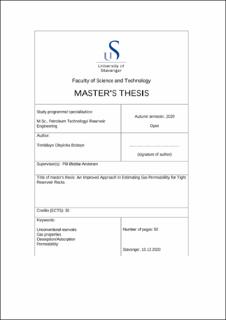| dc.contributor.advisor | Andersen, Pål Østebø | |
| dc.contributor.author | Boboye, Temidayo Olayinka | |
| dc.date.accessioned | 2021-06-16T07:31:23Z | |
| dc.date.available | 2021-06-16T07:31:23Z | |
| dc.date.issued | 2020-12-15 | |
| dc.identifier.uri | https://hdl.handle.net/11250/2759671 | |
| dc.description | Master's thesis in Petroleum Engineering | en_US |
| dc.description.abstract | The impact of the permeability on ultra-tight porous media influences flow behaviour inside the media. The unconventional reservoir gas permeability significantly impacts rock property estimation crucial to unconventional resource development. The rock permeability describes how unconventional reservoir gas flows into the pores, which affects reservoir development. The pressure decay approach estimates the permeability of unconventional rocks by evaluating the pressure difference in reservoirs. Due to the pulsed pressure decay method's effectiveness over the laboratory run time, the analytical solutions determine the permeability. The analytical method to determine the permeability relied on the simulated pressure results, which have limitations in estimating permeability based on constant gas properties. There will be changes between the experimental pressure and the simulated pressure results because these curves have similar late slopes for the estimated permeability. This study aims to eliminate the large differences with inconsistent results between the experimental pressure results' historical matching and those of the simulated pressure results.
A representation of a mathematical model containing gas characteristics related to pressure was developed. When the minimum difference between the experimental pressure and the simulated pressure results stabilizes, the permeability estimation occurs. This study's approach estimated permeability from pulse pressure decay, using laboratory data by testing three gases that include Methane, Helium, and carbon dioxide. This new approach measures the slightest variation in the pressure decay response evaluation based on history matching. This method estimated permeability more accurately when compared with the Cui et al. (2009) analytical solution. The improved estimation of gas permeability in this study was due to the applicability of pressure-dependent gas properties and the entire pressure outcome's implementation to represent pressure decay dynamics. The sensitivity analysis shows that implementing the entire pressure outcome to represent the dynamics of pressure decay is significant in estimating permeability. In contrast, variation in porosity, Langmuir pressure, and Langmuir volume are less significant in the permeability estimation, making the pulse pressure decay approach for estimating permeability to be valid. | en_US |
| dc.language.iso | eng | en_US |
| dc.publisher | University of Stavanger, Norway | en_US |
| dc.relation.ispartofseries | Masteroppgave/UIS-TN-IEP/2020; | |
| dc.subject | petroleumsteknologi | en_US |
| dc.subject | unconventional reservoirs | en_US |
| dc.subject | reservoarteknologi | en_US |
| dc.subject | gas properties | en_US |
| dc.subject | desorption/adsorption | en_US |
| dc.subject | permeability | en_US |
| dc.title | An Improved Approach in Estimating Gas Permeability for Tight Reservoir Rocks. | en_US |
| dc.type | Master thesis | en_US |
| dc.subject.nsi | VDP::Teknologi: 500::Berg‑ og petroleumsfag: 510::Petroleumsteknologi: 512 | en_US |
